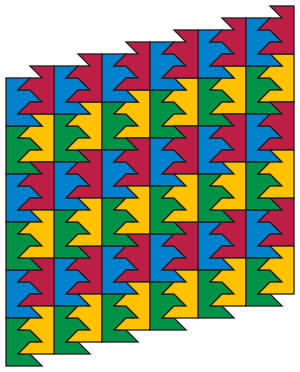Anisohedral tiling

In geometry, a shape is said to be anisohedral if it admits a tiling, but no such tiling is isohedral (tile-transitive); that is, in any tiling by that shape there are two tiles that are not equivalent under any symmetry of the tiling. A tiling by an anisohedral tile is referred to as an anisohedral tiling.[1]
Existence
The first part of Hilbert's eighteenth problem asked whether there exists an anisohedral polyhedron in Euclidean 3-space; Grünbaum and Shephard suggest[2] that Hilbert was assuming that no such tile existed in the plane. Reinhardt answered Hilbert's problem in 1928 by finding examples of such polyhedra, and asserted that his proof that no such tiles exist in the plane would appear soon.[3] However, Heesch then gave an example of an anisohedral tile in the plane in 1935.[4]
Convex tiles
Reinhardt had previously considered the question of anisohedral convex polygons, showing that there were no anisohedral convex hexagons but being unable to show there were no such convex pentagons, while finding the five types of convex pentagon tiling the plane isohedrally.[2] Kershner gave three types of anisohedral convex pentagon in 1968; one of these tiles using only direct isometries without reflections or glide reflections, so answering a question of Heesch.[5]
Isohedral numbers
The problem of anisohedral tiling has been generalised by saying that the isohedral number of a tile is the lowest number orbits (equivalence classes) of tiles in any tiling of that tile under the action of the symmetry group of that tiling, and that a tile with isohedral number k is k-anisohedral. Berglund asked whether there exist k-anisohedral tiles for all k, giving examples for k ≤ 4 (examples of 2-anisohedral and 3-anisohedral tiles being previously known, while the 4-anisohedral tile given was the first such published tile).[6] Goodman-Strauss considered this in the context of general questions about how complex the behaviour of a given tile or set of tiles can be, noting a 10-anisohedral example of Myers.[7] Grünbaum and Shephard had previously raised a slight variation on the same question.[8]
Socolar showed in 2007 that arbitrarily high isohedral numbers can be achieved in two dimensions if the tile is disconnected, or has coloured edges with constraints on what colours can be adjacent, and in three dimensions with a connected tile without colours, noting that in two dimensions for a connected tile without colours the highest known isohedral number is 10.[9]
Joseph Myers has produced a collection of tiles with high isohedral numbers, particularly a polyhexagon with isohedral number 10 (occurring in 20 orbits under translation) and another with isohedral number 9 (occurring in 36 orbits under translation).[1]
References
- ^ Grünbaum, Branko; Shephard, G. C. (1987). Tilings and Patterns. New York: W. H. Freeman and Company. ISBN 0-7167-1193-1.
- ^ a b Grünbaum and Shephard, section 9.6
- ^ Reinhardt, Karl (1928). "Zur Zerlegung der euklidischen Räume in kongruente Polytope". Sitzungsberichte der Preussischen Akamemie der Wissenschaften Berlin, Physikalisch-Mathematische Klasse: 150–155.
- ^ Heesch, H. (1935). "Aufbau der Ebene aus kongruenten Bereichen" (transcription by Berglund, with English translation). Nachrichten von der Gesellschaft der Wissenschaften zu Göttingen, Mathematisch-Physikalische Klasse. Neue Folge. 1: 115–117. Retrieved 2007-09-09.
- ^ Kershner, R. B. (October 1968). "On Paving the Plane". American Mathematical Monthly (fee required). 75 (8). The American Mathematical Monthly, Vol. 75, No. 8: 839–844. doi:10.2307/2314332. JSTOR 2314332.
- ^ Berglund, John (1993). "Is There a k-Anisohedral Tile for k ≥ 5?". American Mathematical Monthly (fee required). 100 (6). The American Mathematical Monthly, Vol. 100, No. 6: 585–588. doi:10.2307/2324621. JSTOR 2324621.
- ^ Goodman-Strauss, Chaim. "Tessellations" (PDF).
- ^ Grünbaum and Shephard, exercise 9.3.2
- ^ Socolar, Joshua E. S. (2007). "Hexagonal Parquet Tilings: k-Isohedral Monotiles with Arbitrarily Large k" (corrected PDF). The Mathematical Intelligencer. 29: 33–38. doi:10.1007/bf02986203. Retrieved 2007-09-09.
External links
- John Berglund, Anisohedral Tilings Page
- Weisstein, Eric W. "Anisohedral Tiling". MathWorld.
- Joseph Myers, Polyomino, polyhex and polyiamond tiling


